The Number of Male Domestic Abuse Victims Is Shockingly High — So Why Don’t We Hear About Them?

Photo: Getty Images
When you think of a victim of domestic abuse, who comes to mind?
If you’re being honest, it’s probably a woman. After all, domestic violence against men isn’t a theme of many Hollywood movies.
Yet in 2010, the Centers for Disease Control and Prevention released data from its National Intimate Partner and Sexual Violence Survey — and one of the most shocking statistics wasn’t just the sheer total of victims of physical violence but also how those numbers broke down by gender.
According to the CDC’s statistics — estimates based on more than 18,000 telephone-survey responses in the United States — roughly 5,365,000 men had been victims of intimate partner physical violence in the previous 12 months, compared with 4,741,000 women. By the study’s definition, physical violence includes slapping, pushing, and shoving.
More severe threats like being beaten, burned, choked, kicked, slammed with a heavy object, or hit with a fist were also tracked. Roughly 40 percent of the victims of severe physical violence were men. The CDC repeated the survey in 2011, the results of which were published in 2014, and found almost identical numbers — with the percentage of male severe physical violence victims slightly rising.
“Reports are also showing a decline of the number of women and an increase in the number of men reporting” abuse, says counselor and psychologist Karla Ivankovich, PhD, an adjunct professor of psychology at the University of Illinois, Springfield.
Ivankovich says there isn’t much buzz about these numbers or their implications, because we don’t know how to handle intimate partner violence against men. “Society supports that men should not hit women, by virtue — but the same is not true for the reverse,” she explains. “The fact is, it’s simply not acceptable to hit anyone.”
Yet, woman-on-man violence is often turned into onscreen amusement, like on a slew of reality shows — or the punch line of a larger, depressing narrative, says Anne P. Mitchell, a retired professor of family law at Lincoln Law School of San Jose (Calif.) and one of the first fathers’-rights lawyers in the country.

She points to the case of John and Lorena Bobbitt, which made national news more than 20 years ago when Lorena cut off her husband’s penis. The aftermath turned into a circus, and details would go on to reveal a volatile marriage, but Mitchell says the initial response of many radio and talk shows was just to laugh at the incident. “If something remotely similar had happened to a woman, there would have been a very different response,” Mitchell tells Yahoo Health.
Mitchell, who has legally represented numerous male victims of domestic violence, says abuse is typically difficult for men to process, let alone seek help for. “Men are brought up to believe it’s not OK to hit a woman or even hit back in self-defense,” she explains. “It is their job to protect her. Add in that you’d be a laughingstock if you said your woman hit you. So in the situation of the battered husband, they don’t know how to feel. They know it’s shameful. They do not want her to get in trouble. So they do not say anything.”
What abuse of men looks like
Physical violence carried out against men is often similar to physical violence against women, Ivankovich says, though it can differ. “Abusive women have been known to abuse in ways similar to men, including punching, kicking, biting, [and] spitting,” she says. “In some instances, to make up for the differences in physical strength, women might use weapons including bats, guns, or knives.”
Sometimes — many times — woman-on-man abuse has nothing to do with thrown punches or weapons. Rather, it’s emotional. “In addition to physical abuse, women also engage in psychological abuse,” Ivankovich adds. “This controlling mechanism can include humiliation, intimidation, and belittling words or statements.”
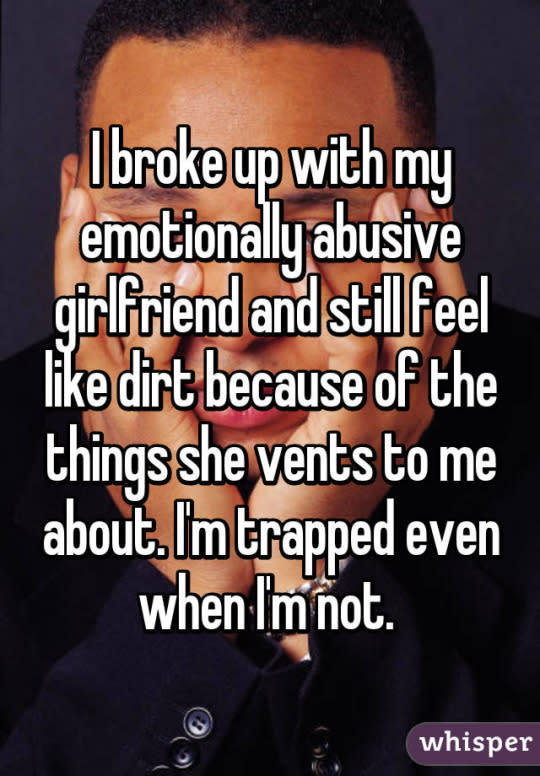
There is another psychological tactic used against men: No one will believe you. Men “fear the possibility that others will think they are lying, or that they are actually the ones perpetrating the abuse,” Ivankovich says.
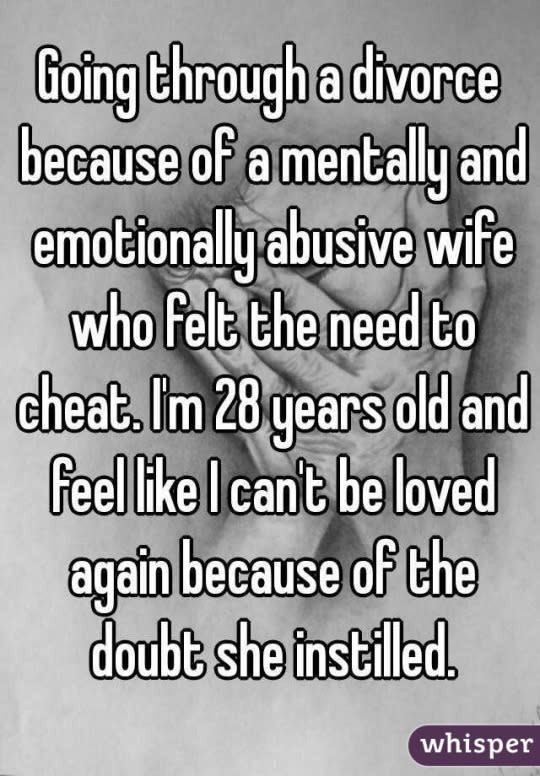
Mitchell says that based on old stereotypes and typical gender roles, it is often very difficult for men to get fair treatment. They are often stuck in situations in which they cannot win. “Many women who are aggressive toward their partners know that if the police are called out, they will arrest the man,” she explains. “I once had a client, who was the mildest guy ever. In no way would he have ever been violent — but his girlfriend was very volatile and a drug user. Once, she was trying to provoke him to hit her. When he wouldn’t respond, she raked her fingernails across his face. He was standing there bleeding when the police arrived at the house. They still arrested him.”
According to Ruth Glenn, executive director of the National Coalition Against Domestic Violence, the reason for abuse is the same for men and women: “It is all about maintaining power and control over a partner,” she tells Yahoo Health. And because “we still live in a patriarchal society, and when it is domestic violence, you are looked at as weaker when you are the victim.”
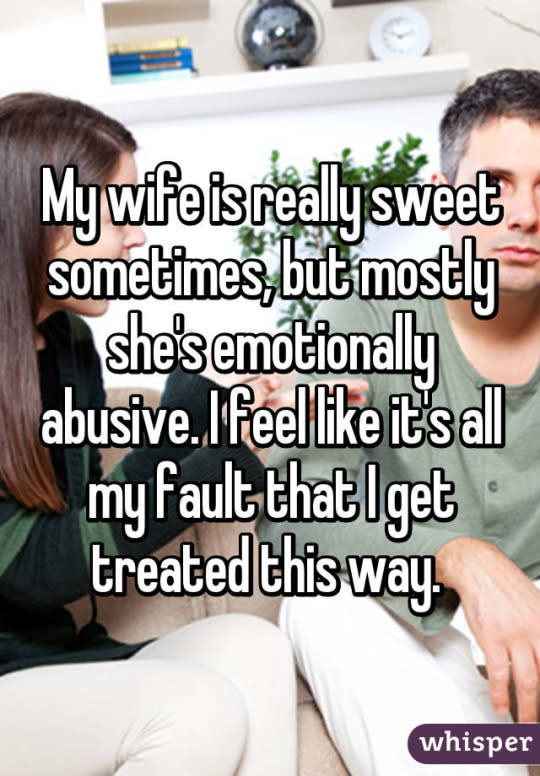
Glenn says we don’t have nearly the data on the actual prevalence of domestic violence against men that we do against women. She says the abuse is more often emotional and psychological.
“Male and female perpetrators of abuse display higher-than-average rates of borderline and narcissistic personality disorders, which are high in that need to ‘control,’” Ivankovich adds. “Men are less likely to seek assistance for this type of abuse, because of the shame and stigma.”
Staying for the children
There are many reasons men stay or do not quietly slip away from abusive partners, many of which are the same reasons women stay in these kinds of relationships. They stay out of shame. Out of fear. Out of love. And not just love for their significant other but for their children.
According to Mitchell, many men stay in abusive relationships for the sake of their kids and the million ways in which a split might affect a child’s well-being. “In a divorce, many women are highly empowered through the court process,” she says. “The idea is that it’s better to have one happy parent than two unhappy parents — and when it comes down to it, the father is not that necessary.”
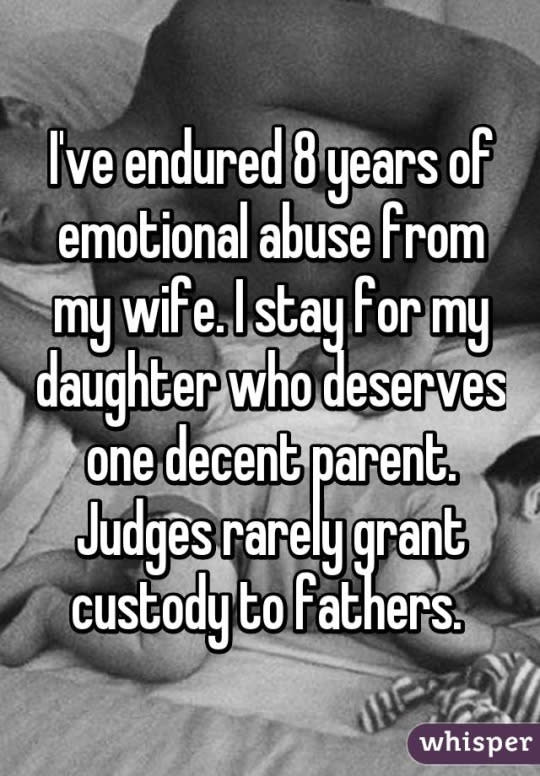
Mitchell says she has had male clients who tried to keep their relationships together to maintain that bond with their children, or even to shield their kids from that volatile partner. “They stay to protect them,” she says. “They don’t want Mom to end up in trouble, or the kids to even realize what is going on.”

The situation is always sticky — and never easy: Stay or leave. Similar to abused wives, even after the demise of the marriage, it can be difficult for a male to escape a toxic partner. Mitchell points to one of her past remarried male clients, who was punched in the face by his ex-wife over a poor report card from their middle-school-age child.
It’s also tough for fathers to remain involved in kids’ day-to-day happenings, from football games to school plays, and continually reinforce to their children that they love them when they’re not always there. Mitchell mentions yet another man, who finally ended his marriage as the abuse escalated: “This man’s ex-wife was very angry and manipulative and tried to cut him out of the kids’ lives.”
He eventually moved from California to New Jersey to cut ties and start over. But he also moved heaven and earth to continue to be a father to his children, despite any parent bad-mouthing that might have been going on when he was not there. “My advice was always to keep trying,” Mitchell says. “Kids have a funny way of growing up and seeing the reality. Dad was there.”
Shifting our cultural perspective on abuse
Glenn says if she could clear up just one misconception about abuse, it’s that it’s a private problem. Just looking at the statistics, victims lose 8 million days of paid work per year, and many lose their jobs. Some estimates also indicate the total cost of intimate partner violence exceeds $8 billion annually, says Glenn.
It’s important to stay vigilant to unexplained “behavior changes” in co-workers, friends, and family members who might be in trouble. “A large myth surrounding domestic violence is that it is a family matter,” says Glenn. “It’s not. Until we stand up and say it’s not, though, we will continue to be a society who won’t address the issue nearly enough.”
We must also keep in mind that there is no one gender immune to violence and psychological manipulation.
“Gender roles are at the crux of this issue,” Ivankovich says. “We still view women as the nurturers and caregivers, and the men as the providers and protectors. To consider that a woman may take on the role as an abuser threatens what we as a society know about gender-role assignment. As a result, many men are told to ‘suck it up,’ or face further shaming for identifying the severity of the problem.”
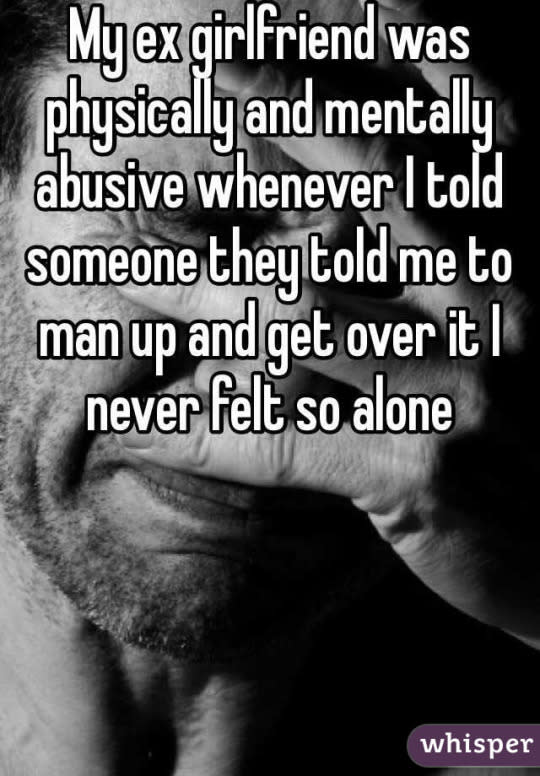
Resources for abused men are scarce, and it’s often problematic for them to report domestic abuse — authorities and others may assign the abuse to them, and perhaps they would lose their children. Perhaps they would be stigmatized.

The culture of abuse needs a full shift in perspective. “Domestic violence and emotional abuse against men is a huge problem — one that needs to be addressed with greater access to resources than what are currently available,” Ivankovich says. “Abuse is abuse. There is no point in which it is OK, especially to condone it for one sex and crucify the other. Anyone who is abused should be able to get help and should be able to do so in an environment that is not shameful or accusatory.”
We need to encourage abused men to get help as well. According to Glenn, the signs of abuse in men are usually the same as in women. “Look for behavioral changes, isolation — they’ll suddenly disappear from your social circle, and they’re not willing to talk about it,” she explains. “Often, there’s a lot of controlling behavior by the partner. Money is often withheld, or they have to constantly check in.”

Women absolutely experience domestic violence too, including sexual violence and stalking at higher rates than men — which is something that should never be downplayed. A victim is a victim. No abuse should be tolerated; the toll of abuse on both men and women is enormous.
The stats are only whispered. But the estimates are alarming: 20 people are abused by an intimate partner every minute — 10 million people per year.
Chances are, you know one.
Confessions provided by Whisper, the free app that allows users to share their secrets anonymously. For more confessions about emotional health and relationships, check out Whisper.
Read This Next: ‘This Was The Beginning of My Fear’: 8 Truths About Stalking You Need to Know
